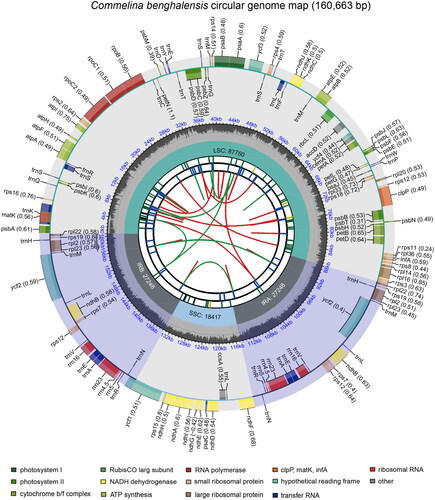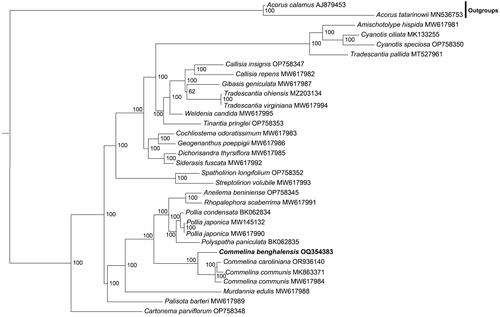Figures & data
Figure 1. Habitat photos of Commelina benghalensis.
The photos were taken by Liqiang Wang. Panel A shows a panorama, Panel B shows a detail, and Panel C shows the flowers. The plant's coordinates are N 35° 16′ 23.62″, E 115° 27′ 36.01″. It's a perennial herb with mostly creeping stems reaching up to 70 cm in height and ovate leaves measuring 3-7 cm long. The flowers, enclosed in funnel-shaped bracts, bloom in the summer to autumn season. This plant thrives in tropical and subtropical wetlands, from near sea level to 2300 meters in altitude.

Figure 2. Schematic map of overall features of the commelina benghalensis plastome.
From the inside out, the first track shows dispersed repeats, which consist of direct and palindromic repeats connected by red and green arcs. The second track shows long tandem repeats as short blue bars, while the third track shows short tandem repeats or microsatellite sequences as short bars with different colors. The fourth track shows the small single-copy, inverted repeat, and large single-copy regions. The fifth track displays the GC content along the genome, and the sixth track shows genes color-coded by their functional classification and transcription direction. The species name is shown in the top left corner, and the bottom left corner provides the functional classification of the genes.

Figure 3. The phylogenetic tree of 30 Commelinaceae species and two outgroups. The tree was constructed with complete plastome sequences present in all 23 species using the maximum likelihood method. The 23 species were Acorus calamus (AJ879453, outgroup) (Goremykin et al. Citation2005), Acorus tatarinowii (MN536753, outgroup) (Ma et al. Citation2020), Amischotolype hispida (MW617981) (Jung et al. Citation2021), Cyanotis ciliata (MK133255), Cyanotis speciosa (OP758350), Tradescantia pallida (MT527961) (Gao et al. Citation2020), Callisia insignis (OP758347), Callisia repens (MW617982) (Jung et al. Citation2021), Gibasis geniculate (MW617987) (Jung et al. Citation2021), Tradescantia ohiensis (MZ203134) (Liu et al. Citation2021), Tradescantia virginiana (MW617994) (Jung et al. Citation2021), Weldenia candida (MW617995) (Saha and Jha Citation2019), Tinantia pringlei (OP758353), Cochliostema odoratissimum (MW617983) (Jung et al. Citation2021), Geogenanthus poeppigii (MW617986) (Jung et al. Citation2021), Dichorisandra thyrsiflora (MW617985) (Jung et al. Citation2021), Siderasis fuscata (MW617992) (Jung et al. Citation2021), Spatholirion longifolium (OP758352), Streptolirion volubile (MW617993) (Jung et al. Citation2021), Aneilema beniniense (OP758345), Rhopalephora scaberrima (MW617991) (Jung et al. Citation2021), Pollia condensata (BK062834), Pollia japonica (MW145132) (Gu and Ma Citation2021), Pollia japonica (MW617990), Polyspatha paniculata (BK062835), Commelina benghalensis (OQ354383, this study), Commelina caroliniana (OR936140), Commelina communis (MK863371) (Cui and Liang Citation2019), Commelina communis (MW617984), Murdannia edulis (MW617988) (Jung et al. Citation2021), and Palisota barteri (MW617989) (Jung et al. Citation2021), Cartonema parviflorum (OP758348). Bootstrap supports were calculated from 1000 replicates. The Commelina benghalensis was labeled in bold font in the phylogenetic tree

Supplemental Material
Download MS Word (1,005.3 KB)Data availability statement
The plastome sequence has been deposited in GenBank (https://www.ncbi.nlm.nih.gov/genbank/) with the accession number OQ354383 (https://www.ncbi.nlm.nih.gov/nuccore/OQ354383). The associated BioProject, Bio-Sample, and SRA numbers are PRJNA928567, SAMN36852649 and SRR23251264. (https://www.ncbi.nlm.nih.gov/sra/?term=SRR12620715).
